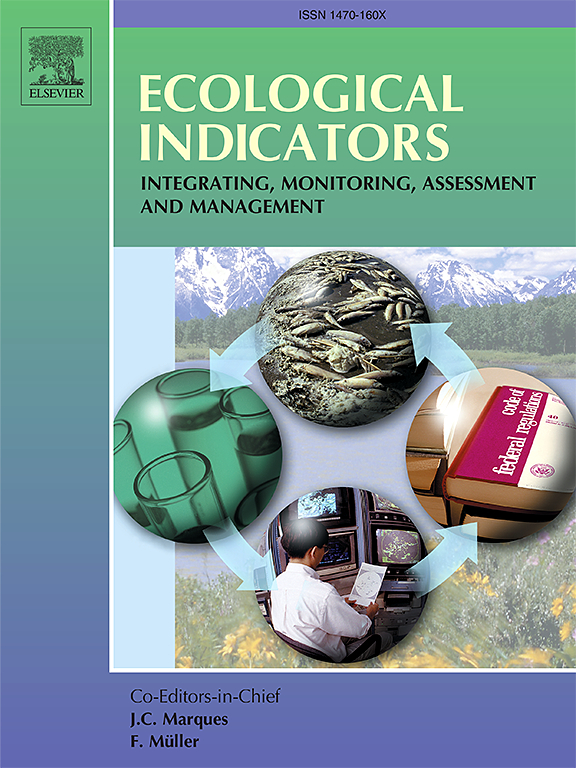丹江口库区生态服务功能最优保护优先级的综合评价与情景模拟
IF 7
2区 环境科学与生态学
Q1 ENVIRONMENTAL SCIENCES
引用次数: 0
摘要
确定生态系统服务的保护优先事项对于协调环境可持续性与人类福祉以及加强可持续资源管理至关重要。然而,单一评价指标的使用和模糊方法划定保护优先次序导致决策过程中的偏差。以南水北调中线工程始发点和主要水源丹江口库区(DRA)为研究对象,采用InVEST模型量化2000 - 2020年丹江口库区碳储量(CS)、生境质量(HQ)、产水量(WY)、水质净化(WP)和土壤保持(SC) 5个关键ESs,利用有序加权算法(OWA)模拟了7个待解决的优先情景。结合层次分析法(AHP),构建了空间分布合理性、保护效率、权衡程度和政策遵从性相结合的评价指标体系,量化各待决情景的得分,从而确定最优保护优先级。结果表明,这些ESs随时间逐渐下降。在空间上,CS、HQ、WP和SC表现出很强的协同效应,而WY与它们表现出显著的权衡。最优保护优先区面积为0.35 × 104 km2,主要位于青藏高原南部和中部的高山丘陵地带,以森林和草地为主。它既具有较高的节约效率,又具有基于政策遵从性的空间分布合理性,有效地协调了各ESs之间的关系。本研究为确定最优保护优先级的量化和可视化提供了新的见解。研究结果可为水源地和高水源地的保护和管理策略提供参考。本文章由计算机程序翻译,如有差异,请以英文原文为准。

Comprehensive evaluation and scenario simulation for determining the optimal conservation priority of ecological services in Danjiangkou Reservoir Area, China
The identification of conservation priority for ecosystem services (ESs) holds paramount importance in harmonizing environmental sustainability with human well-being and bolstering sustainable resource management. However, the utilization of a singular evaluation indicator and the employment of ambiguous methods for delineating conservation priorities have resulted in deviations in the decision-making processes. This study focused on the Danjiangkou Reservoir Area (DRA), the originating point and primary water source for the middle route of the South-to-North Water Transfer Project, and employed the InVEST model to quantify five key ESs, including carbon storage (CS), habitat quality (HQ), water yield (WY), water purification (WP), and soil conservation (SC) for the period spanning from 2000 to 2020 to simulate seven pending priority scenarios by utilizing the ordered weighting algorithm (OWA). Additionally, it incorporated the analytic hierarchy process (AHP) to formulate an evaluation indicator system that combines spatial distribution rationality, conservation efficiency, degree of trade-off, and policy compliance to quantify the scores for each pending scenario, thereby facilitating the determination of the optimal conservation priority. The results indicate a gradual temporal decline in these ESs. Spatially, CS, HQ, WP, and SC show strong synergies, while WY exhibits significant trade-offs with them. The optimal conservation priority, with a total area of 0.35 × 104 km2 and primarily located in the high mountainous and hilly regions in the southern and central parts of DRA, is covered by forest and grass land. It exhibits both high conservation efficiency and spatial distribution rationality, which are based on the policy compliance and effectively coordinates relationships among various ESs. This study offers new insights into the quantification and visualization of the identification of optimal conservation priority. The outcomes serve as a reference for informing the protection and management strategies of water source areas and regions with a high supply of ESs.
求助全文
通过发布文献求助,成功后即可免费获取论文全文。
去求助
来源期刊

Ecological Indicators
环境科学-环境科学
CiteScore
11.80
自引率
8.70%
发文量
1163
审稿时长
78 days
期刊介绍:
The ultimate aim of Ecological Indicators is to integrate the monitoring and assessment of ecological and environmental indicators with management practices. The journal provides a forum for the discussion of the applied scientific development and review of traditional indicator approaches as well as for theoretical, modelling and quantitative applications such as index development. Research into the following areas will be published.
• All aspects of ecological and environmental indicators and indices.
• New indicators, and new approaches and methods for indicator development, testing and use.
• Development and modelling of indices, e.g. application of indicator suites across multiple scales and resources.
• Analysis and research of resource, system- and scale-specific indicators.
• Methods for integration of social and other valuation metrics for the production of scientifically rigorous and politically-relevant assessments using indicator-based monitoring and assessment programs.
• How research indicators can be transformed into direct application for management purposes.
• Broader assessment objectives and methods, e.g. biodiversity, biological integrity, and sustainability, through the use of indicators.
• Resource-specific indicators such as landscape, agroecosystems, forests, wetlands, etc.
 求助内容:
求助内容: 应助结果提醒方式:
应助结果提醒方式:


